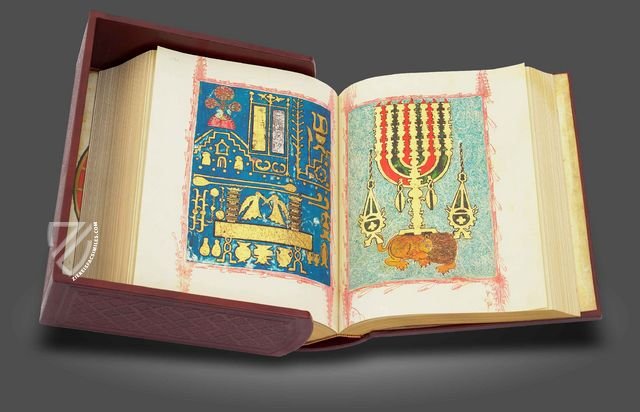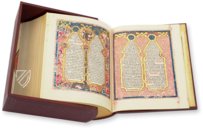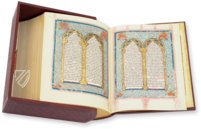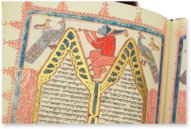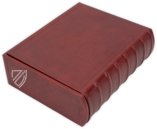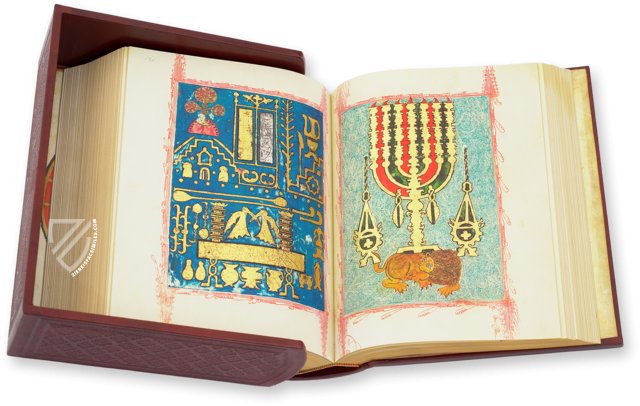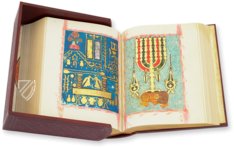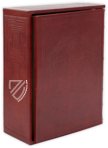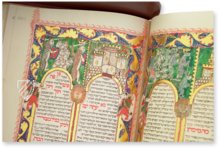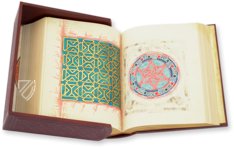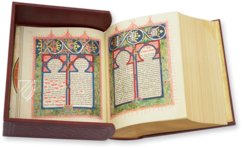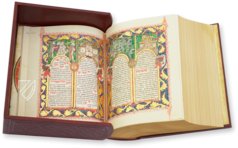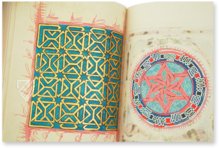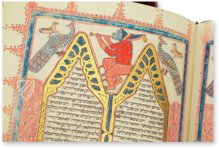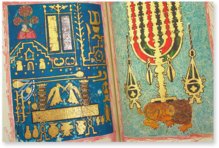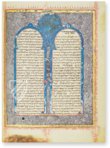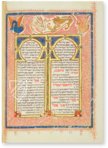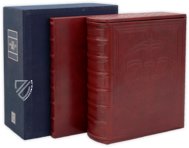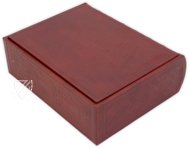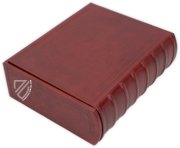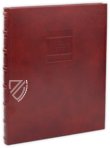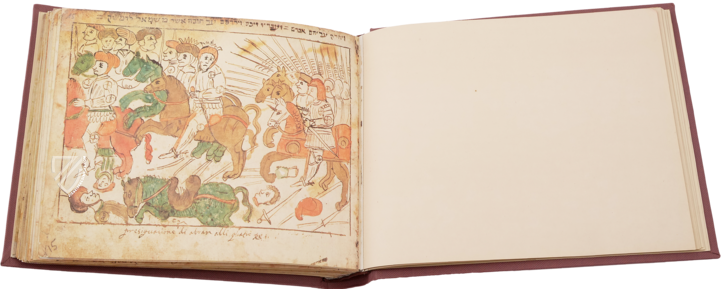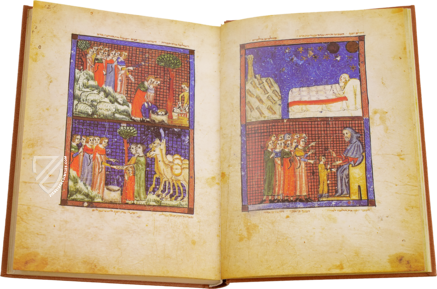Kennicott Bible
(7,000€ - 10,000€)
The Kennicott Bible counts among the most significant medieval manuscripts from Spain. It is a noble, exceptional work containing a Hebrew Bible, which contains the text Sefer Michlol by Rabbi David Kihmhi alongside the Tanakh. The colophon at the end of the manuscript, in which the scribe has immortalized himself by name, is a special feature that is extremely useful to scholarship: in 1476, the famous Moses Ibn Zaraba completed the work with the help of the illuminator Joseph Ibn Hayyim in La Coruna in northwestern Spain. The 922 pages of this Hebrew Bible, which is amazingly preserved in its original gorgeous binding, combines an exuberant and golden splendor of splendid ornaments, wonderful carpet pages and figurative representations, often of a humorous character. The magnificent manuscript received its name from the Hebraist and Christian cleric Benjamin Kennicott, who researched the manuscript in the 18th century.
Kennicott Bible
The Kennicott Biblecounts among the most significant medieval manuscripts from Spain. It is a noble, exceptional work containing a Hebrew Bible, which contains the text Sefer Michlol by Rabbi David Kihmhi alongside the Tanakh. As a special feature in the colophon at the end of the Kennicott Bible, the scribe immortalized himself: the famous Moses Ibn Zabara, who completed the work in 1476 in La Coruna in Northwestern Spain. This Hebrew Bible, preserved in its original, gorgeous binding unites gloriously ornamental and figurative book decoration on 922 pages. It gained its name from the Hebraist Benjamin Kennicot, who researched the manuscript in the 18th century. A truly noble treasure!
Noble Ornamentation in Consummate Execution
The adornment of the Kennicott Bible makes it something exceptional. 24 canonical book titles and 49 parashah titles are embellished with ornamental depictions. The ornamentation of this title is made up of zoomorphic figures, designed with glorious colors and splendidly gilded. An extremely noble appearance and very accurate execution characterize the style of the Kennicott Bible. This is particularly clear on the 27 pages of the Sefer Michlol, which is splendidly adorned all over with arcade architecture. The carpet pages, which additionally decorate the manuscript, round out this accomplished picture!
A Spanish Treasure
The Kennicott Bible was made in La Coruna, Spain in 1475 as a commission for Isaac, son of Don Salomon de Braga. A colophon at the end of the manuscript indicates the 24th of June, 1476 as the bible’s date of completion. This unusual detail for a Hebrew Bible is the work of the scribe Moses Ibn Zabara, who wanted to immortalize himself in this manner. Zabara was supported in his work on the bible by the painter Joseph Ibn Hayyim. Together they created a true masterpiece of medieval Spanish illumination in the Kennicott Bible!
Tanakh and Sefer Michlol
Alongside the Tanakh, the Kennicott Bible contains the text Sefer Michlol, a grammatical treatise by Rabbi David Kihmhi. This composition is appropriately dignified through the employment of fine, fantastical ornamentation and precious gold leaf, which shines on all the pages. Benjamin Kennicott (1718–1783), an English Hebraist, made the bible famous through his study of it. Kennicot, who was employed as the canon of Christ Church in Oxford, pursued an intense study of Hebrew Bible texts and published these in a few standard references. As an acknowledgement of this, one of the most exceptional manuscripts of medieval Spain bears his name!
Codicology
- Alternative Titles
- Kennicott-Bibel
- Size / Format
- 922 pages / 32.0 × 26.2 cm
- Origin
- Spain
- Date
- 1476
- Epochs
- Style
- Language
- Script
- Sephardi script
- Illustrations
- 24 canonical book headings, 49 parashah headings structured with gold in different motifs featuring zoomorphic figures in many colors, 27 lavishly-illuminated arcaded pages framing the text of the Sefer Mikhlol, 9 fully illuminated carpet pages, 150 Psalm headings, numbered and illuminated with gold and silver
- Patron
- Isaac de Braga
- Artist / School
- Moses Ibn Zabara (scribe)
Joseph Ibn Hayyim (illuminator) - Previous Owners
- Radcliffe Library
Benjamin Kennicott (1718–83)
Kennicott Bible
Zoomorphic Marginalia
Aside from their truly excellent calligraphy, Jewish manuscripts are renowned for their zoomorphic decoration. The four creatures that appear in this elaborately patterned red-blue border above the text in golden frames include two long-necked birds resembling swans, but brightly colored, as well as two mythical creatures. A winged dragon on the left faces off against what appears to be a horned lion and the tails of the battling beasts have become intertwined.

Kennicott Bible
Temple Menorah
Although the fate of the original menorah set up by Moses in the tabernacle in the wilderness, which later resided in the Temple of Solomon, is not recorded, the menorah from the Second Temple was taken back to Rome after the conquest of Jerusalem in AD 70. It was then carried off by the Vandals after they sacked Rome in 455 to their new capital of Carthage.
The menorah was recovered by the Byzantine general Belisarius after he defeated the Vandals in 533 and brought back to Constantinople. The Emperor Justinian I, prompted by superstitious fear that it had been unlucky for Rome and Carthage, sent it back to Jerusalem, at which point it disappears from the historical record. It is depicted here with the Lion of Judah sleeping at tits base.
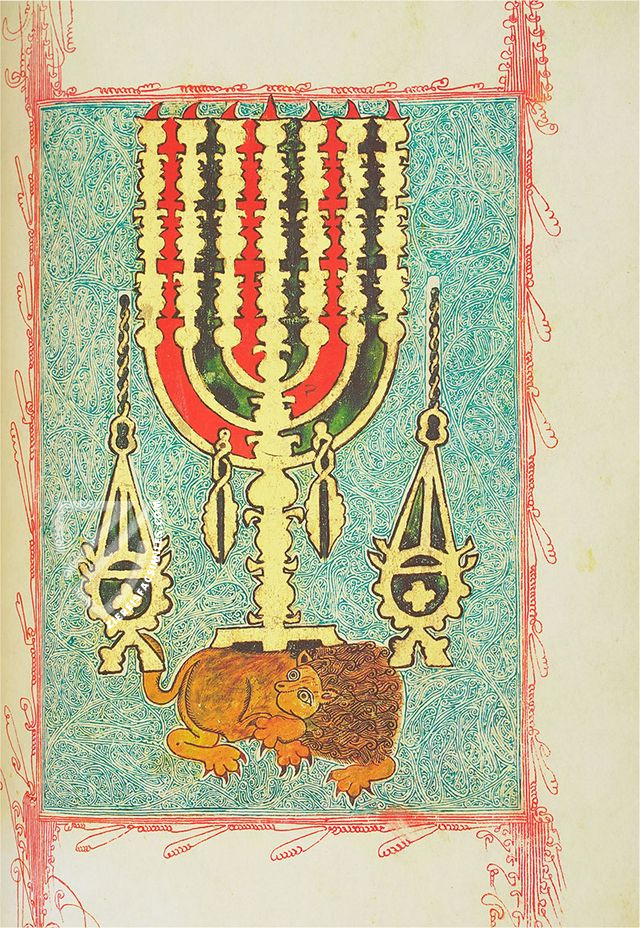
#1 The Kennicott Bible
Language: English
(7,000€ - 10,000€)
- Treatises / Secular Books
- Apocalypses / Beatus
- Astronomy / Astrology
- Bestiaries
- Bibles / Gospels
- Chronicles / History / Law
- Geography / Maps
- Saints' Lives
- Islam / Oriental
- Judaism / Hebrew
- Single Leaf Collections
- Leonardo da Vinci
- Literature / Poetry
- Liturgical Manuscripts
- Medicine / Botany / Alchemy
- Music
- Mythology / Prophecies
- Psalters
- Other Religious Books
- Games / Hunting
- Private Devotion Books
- Other Genres
- Afghanistan
- Armenia
- Austria
- Belgium
- Colombia
- Croatia
- Cyprus
- Czech Republic
- Denmark
- Egypt
- Ethiopia
- France
- Germany
- Greece
- Hungary
- India
- Iran
- Iraq
- Israel
- Italy
- Japan
- Lebanon
- Luxembourg
- Mexico
- Morocco
- Netherlands
- Palestine
- Peru
- Poland
- Portugal
- Russia
- Serbia
- Spain
- Sri Lanka
- Sweden
- Switzerland
- Syria
- Turkey
- Ukraine
- United Kingdom
- United States
- Uzbekistan
- Aboca Museum
- Ajuntament de Valencia
- Akademie Verlag
- Akademische Druck- u. Verlagsanstalt (ADEVA)
- Aldo Ausilio Editore - Bottega d’Erasmo
- Alecto Historical Editions
- Alkuin Verlag
- Almqvist & Wiksell
- Amilcare Pizzi
- Andreas & Andreas Verlagsbuchhandlung
- Archa 90
- Archiv Verlag
- Archivi Edizioni
- Arnold Verlag
- ARS
- Ars Magna
- ArtCodex
- AyN Ediciones
- Azimuth Editions
- Badenia Verlag
- Bärenreiter-Verlag
- Belser Verlag
- Belser Verlag / WK Wertkontor
- Benziger Verlag
- Bernardinum Wydawnictwo
- BiblioGemma
- Biblioteca Apostolica Vaticana (Vaticanstadt, Vaticanstadt)
- Bibliotheca Palatina Faksimile Verlag
- Bibliotheca Rara
- Boydell & Brewer
- Bramante Edizioni
- Bredius Genootschap
- Brepols Publishers
- British Library
- C. Weckesser
- Caixa Catalunya
- Canesi
- CAPSA, Ars Scriptoria
- Caratzas Brothers, Publishers
- Carus Verlag
- Casamassima Libri
- Chavane Verlag
- Christian Brandstätter Verlag
- Circulo Cientifico
- Club Bibliófilo Versol
- Club du Livre
- CM Editores
- Collegium Graphicum
- Collezione Apocrifa Da Vinci
- Comissão Nacional para as Comemorações dos Descobrimentos Portugueses
- Coron Verlag
- Corvina
- CTHS
- D. S. Brewer
- Damon
- De Agostini/UTET
- De Nederlandsche Boekhandel
- De Schutter
- Deuschle & Stemmle
- Deutscher Verlag für Kunstwissenschaft
- DIAMM
- Droz
- E. Schreiber Graphische Kunstanstalten
- Ediciones Boreal
- Ediciones Grial
- Ediclube
- Edições Inapa
- Edilan
- Editalia
- Edition Deuschle
- Edition Georg Popp
- Edition Leipzig
- Edition Libri Illustri
- Editiones Reales Sitios S. L.
- Éditions de l'Oiseau Lyre
- Editions Medicina Rara
- Editorial Casariego
- Editorial Mintzoa
- Editrice Antenore
- Editrice Velar
- Edizioni Edison
- Egeria, S.L.
- Eikon Editores
- Electa
- Emery Walker Limited
- Enciclopèdia Catalana
- Eos-Verlag
- Ephesus Publishing
- Ernst Battenberg
- Eugrammia Press
- Extraordinary Editions
- Fackelverlag
- Facsimila Art & Edition
- Facsimile Editions Ltd.
- Facsimilia Art & Edition Ebert KG
- Faksimile Verlag
- Feuermann Verlag
- Folger Shakespeare Library
- Franco Cosimo Panini Editore
- Friedrich Wittig Verlag
- Fundación Hullera Vasco-Leonesa
- G. Braziller
- Gabriele Mazzotta Editore
- Gebr. Mann Verlag
- Gesellschaft für graphische Industrie
- Getty Research Institute
- Giovanni Domenico de Rossi
- Giunti Editore
- Graffiti
- Grafica European Center of Fine Arts
- Guido Pressler
- Guillermo Blazquez
- Gustav Kiepenheuer
- H. N. Abrams
- Harrassowitz
- Helikon
- Hendrickson Publishers
- Henning Oppermann
- Herder Verlag
- Hes & De Graaf Publishers
- Hoepli
- Holbein-Verlag
- Hortus Deliciarum
- Houghton Library
- Hugo Schmidt Verlag
- Idion Verlag
- Il Bulino, edizioni d'arte
- ILte
- Imago
- Insel Verlag
- Instituto Nacional de Antropología e Historia
- Istituto dell'Enciclopedia Italiana - Treccani
- Istituto Ellenico di Studi Bizantini e Postbizantini
- Istituto Geografico De Agostini
- Istituto Poligrafico e Zecca dello Stato
- Italarte Art Establishments
- J. Thorbecke
- Jan Thorbecke Verlag
- Johnson Reprint Corporation
- Josef Stocker
- Josef Stocker-Schmid
- Jugoslavija
- Karl W. Hiersemann
- Kasper Straube
- Kaydeda Ediciones
- Kindler Verlag / Coron Verlag
- Kodansha International Ltd.
- Konrad Kölbl Verlag
- Kurt Wolff Verlag
- La Liberia dello Stato
- La Linea Editrice
- La Meta Editore
- Lambert Schneider
- Landeskreditbank Baden-Württemberg
- Leo S. Olschki
- Les Incunables
- Library of Congress
- Libreria Musicale Italiana
- Lichtdruck
- Lito Immagine Editore
- Lumen Artis
- Lund Humphries
- M. Moleiro Editor
- Maison des Sciences de l'homme et de la société de Poitiers
- Manuscriptum
- Martinus Nijhoff
- Maruzen-Yushodo Co. Ltd.
- MASA
- McGraw-Hill
- Militos
- Millennium Liber
- Müller & Schindler
- Nahar and Steimatzky
- National Library of Wales
- Neri Pozza
- Nova Charta
- Oceanum Verlag
- Odeon
- Orbis Mediaevalis
- Orbis Pictus
- Österreichische Staatsdruckerei
- Oxford University Press
- Pageant Books
- Parzellers Buchverlag
- Patrimonio Ediciones
- Pattloch Verlag
- PIAF
- Pieper Verlag
- Plon-Nourrit et cie
- Prestel Verlag
- Princeton University Press
- Prisma Verlag
- Priuli & Verlucca, editori
- Pro Sport Verlag
- Propyläen Verlag
- Pytheas Books
- Quaternio Verlag Luzern
- Reales Sitios
- Recht-Verlag
- Reichert Verlag
- Reichsdruckerei
- Riehn & Reusch
- Roberto Vattori Editore
- Rosenkilde and Bagger
- Roxburghe Club
- Salerno Editrice
- Sarajevo Svjetlost
- Schöck ArtPrint Kft.
- Scolar Press
- Scrinium
- Scripta Maneant
- Scriptorium
- Siloé, arte y bibliofilia
- SISMEL - Edizioni del Galluzzo
- Sociedad Mexicana de Antropología
- Société des Bibliophiles & Iconophiles de Belgique
- Soncin Publishing
- Sorli Ediciones
- Stainer and Bell
- Studer
- Styria Verlag
- Sumptibus Pragopress
- Szegedi Tudomànyegyetem
- Taberna Libraria
- Tarshish Books
- Taschen
- Tempus Libri
- Testimonio Compañía Editorial
- Thames and Hudson
- The Clear Vue Publishing Partnership Limited
- The Facsimile Codex
- The Folio Society
- The Marquess of Normanby
- The Richard III and Yorkist History Trust
- Tip.Le.Co
- TouchArt
- TREC Publishing House
- TRI Publishing Co.
- Trident Editore
- Typis Regiae Officinae Polygraphicae
- Union Verlag Berlin
- Universidad de Granada
- University of California Press
- University of Chicago Press
- Urs Graf
- Vallecchi
- Van Wijnen
- VCH, Acta Humaniora
- VDI Verlag
- VEB Deutscher Verlag für Musik
- Verlag Anton Pustet / Andreas Verlag
- Verlag Bibliophile Drucke Josef Stocker
- Verlag der Münchner Drucke
- Verlag für Regionalgeschichte
- Verlag Styria
- Vicent Garcia Editores
- W. Turnowsky
- Waanders Printers
- Wiener Mechitharisten-Congregation (Wien, Österreich)
- Wissenschaftliche Buchgesellschaft
- Wydawnictwo Dolnoslaskie
- Xuntanza Editorial
- Zakład Narodowy
- Zollikofer AG

